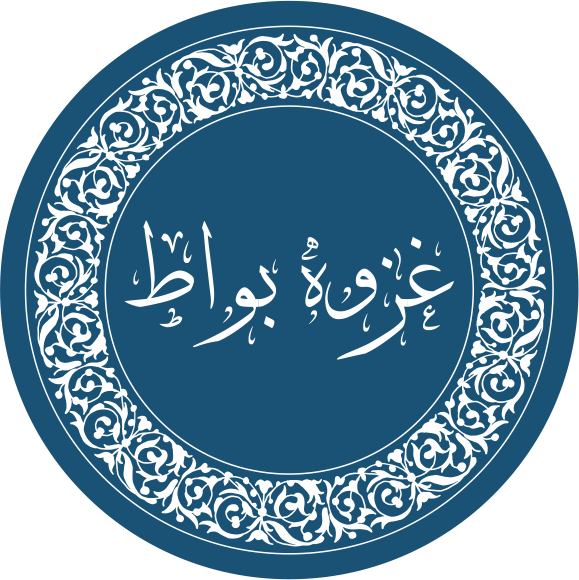Expedition of Buwat | Interception of the Quraysh Trade Route
Published on: 15-Feb-2024
(Cite: Hamdani, Mufti Shah Rafi Uddin & Khan, Dr. (Mufti) Imran. (2024, February 15). Expedition of Buwat 2 A.H.. Encyclopedia of Muhammad  .)
.)
13 months after the migration to Madinah, 1 in the month of Rabi' Al-Awwal, 2 A.H., the Holy Prophet formed a battalion of 200 companions 2 comprising only of Muhajireen 3 and led them towards Buwat which is near the mountain of Radhwa (رضویٰ). 4 It was the famous route of Makkans to go to Syria for trade. At the time of the expedition of Buwat 2 A.H., a caravan of Quraysh was passing by that route. Prophet Muhammad
formed a battalion of 200 companions 2 comprising only of Muhajireen 3 and led them towards Buwat which is near the mountain of Radhwa (رضویٰ). 4 It was the famous route of Makkans to go to Syria for trade. At the time of the expedition of Buwat 2 A.H., a caravan of Quraysh was passing by that route. Prophet Muhammad  decided to raid that trade caravan which was returning from Syria and was heading towards Makkah. Some historians state that the army was comprised of both, the Muhajireen and the Ansar, 5 however, the prevailing view is that the contingent was only comprised of Muhajireen.
decided to raid that trade caravan which was returning from Syria and was heading towards Makkah. Some historians state that the army was comprised of both, the Muhajireen and the Ansar, 5 however, the prevailing view is that the contingent was only comprised of Muhajireen.
The standard of the army, which was white in color, 6 was given to Saad ibn Abi Waqas  , while the vicegerency and responsibility of the affairs of Madinah in the absence of the Holy Prophet
, while the vicegerency and responsibility of the affairs of Madinah in the absence of the Holy Prophet  were given to Saad ibn Muaz
were given to Saad ibn Muaz  . 7 Ibn Hisham 8 and many other historians have quoted Saib ibn Usman ibn Maz’un’s
. 7 Ibn Hisham 8 and many other historians have quoted Saib ibn Usman ibn Maz’un’s  name as the leader in the absence of Prophet Muhammad
name as the leader in the absence of Prophet Muhammad  , which is more authentic. 9
, which is more authentic. 9
The Makkan trade caravan consisted of 2500 camels, guarded, and accompanied by 100 armed men of the Quraysh. The caravan was led by Umayyah ibn Khalf, 10 who was a major enemy of Islam. 11 When the Muslims reached Buwat (بواط), 12 the mountain among the mountains of the Juhaina tribe, 24 miles away from Madinah, they realized that they had missed the Quraysh caravan, thus, no battle took place. 13 The Muslims, under the leadership of Prophet Muhammad  , stayed at Buwat, for a month. 14 During his stay at Buwat, the Holy Prophet
, stayed at Buwat, for a month. 14 During his stay at Buwat, the Holy Prophet  strengthened his relations with the tribe of Juhnia and tried to establish ties with prospective allies 15 and returned to Madinah.
strengthened his relations with the tribe of Juhnia and tried to establish ties with prospective allies 15 and returned to Madinah.
- 1 Abu Al-Abbas Ahmed ibn Ali Al-Husaini (1999), Imta’ Al-Asma bima lin Nabi Min Al-Ahwal wal-Amwal wal-Hafadah wal-Mata’a, Dar Al-Kutub Al-Ilmiyah, Beirut, Lebanon, Vol. 1, Pg. 74.
- 2 Safi Al-Rahman Al-Mubarakpuri (2010), Al-Raheeq Al-Makhtum, Dar ibn Hazam, Beirut, Lebanon, Pg. 219.
- 3 Muhammad ibn Abd Al-Baqi ibn Yusuf Al-Zurqani (2012), Sharah Al-Zurqani ‘Ala Al-Mawahib Al-Laduniyyah, Dar Al-Kutub Al-Ilmiyah, Beirut, Lebanon, Vol. 2, Pg. 231.
- 4 Abu Abdullah Yaqut ibn Abdullah Al-Hamwi (1995), M’ujam Al-Buldan, Dar Sadir, Beirut, Lebanon, Vol. 3, Pg. 51.
- 5 Abu Shuhba Muhammad ibn Suwaylam (1427 A.H.), Al-Seerah Al-Nabawiyyah ‘Ala Doo Al-Quran Wal-Sunnah, Dar Al-Qalam, Damascus, Syria, Vol. 2, Pg. 117.
- 6 Abu Al-Fatah Muhammad ibn Syed Al-Naas (1993), ‘Uyoon Al-Athar fi Funoon Al-Maghazi wal-Shamail wal-Siyar, Dar Al-Qalam, Beirut, Lebanon, Vol. 1, Pg. 262.
- 7 Muhammad ibn Saad Al-Basri (1968), Al-Tabqat Al-Kubra, Dar Sadir, Beirut, Lebanon, Vol. 2, Pg. 8.
- 8 Abd Al-Malik ibn Hisham (2009), Al-Seerat Al-Nabawiyah le-ibn Hisham, Dar Al-Kutub Al-Ilmiyah, Beirut, Lebanon, Pg. 410.
- 9 Muhammad ibn Yusuf Al-Salihi Al-Shami (1993), Subul Al-Huda wal-Rashad fi Seerat Khair Al-‘Ibad, Dar Al-Kutub Al-Ilmiyah, Beirut, Lebanon, Vol. 4, Pg. 15.
- 10 Abu Abdullah Muhammad ibn Abu Bakr ibn Qayyam Al-Jawzi (2005), Zaad Al-Ma’ad, Muassasah Al-Risala, Beirut, Lebanon, Vol. 3, Pg. 148.
- 11 Martin Lings (1985), Muhammad: His Life Based on the Earliest Sources, Suhail Academy, Lahore, Pakistan, Pg. 135.
- 12 Muhammad ibn Yusuf Al-Salihi Al-Shami (2013), Subul Al-Huda wal-Rashad fi Seerat Khair Al-‘Ibad, Dar Al-Kutub Al-Ilmiyah, Beirut, Lebanon, Vol. 4, Pg. 15.
- 13 Abd Al-Malik ibn Hisham (2009), Al-Seerat Al-Nabawiyah le-ibn Hisham, Dar Al-Kutub Al-Ilmiyah, Beirut, Lebanon, Pg. 411.
- 14 Abul Fida Ismael ibn Kathir Al-Damishqi (1976), Al-Seerat Al-Nabawiyah le-ibn Kathir, Dar Al-Ma’rifa lil Taba’a wal-Nashr wal-Tawzi, Beirut, Lebanon, Vol. 2, Pg. 361.
- 15 Dr. Nasir Majeed Malik (2020), Holy Prophet’s (ﷺ) Intelligence System, Paramount Printing Press, Karachi, Pakistan, Pg. 89.